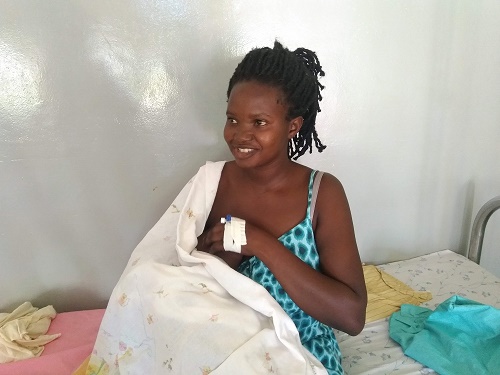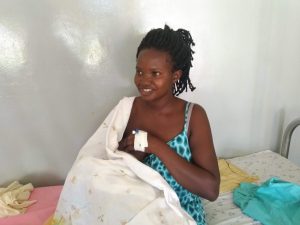

The time around childbirth is very critical to both mother and baby and it is when many lives are lost or left with serious morbidities if the right care is not received in time. Ms Sarah Acheng of Mayuge District near the South Eastern shores of Lake Victoria and her baby almost found their way to Uganda’s records of maternal and newborn mortality statistics.
For Sarah, the birth pangs did not only come late at 41 weeks which caused her anxiety, it was also on a rainy day when she had no access to a car to the nearest health facility over five kilometres away from her home. The rains were relentless and not even a motor cycle taxi (commonly known as boda boda) could move on the slippery road. With her labour pains, Sarah in company of her mother slowly made their way on foot to Kigandalo Health Centre IV.
In Sarah’s own words:
“The midwife I found on duty told me that the uterus wasn’t opening. I was here for two days and wasn’t progressing. When the doctor came, he said I had a problem with my pelvis with one side opening but not the other. It was in the evening when there was no electricity and it was threatening to rain. He suggested a referral and I chose to go to Bugiri Hospital. We reached hospital at about 8 pm and the midwives I found on duty were welcoming and helpful. The one who examined me said there was a chance my pelvis could still open up. She also found me with a urinary tract infection and initiated me on treatment. We went through the night struggling with my cervix opening up from 3cm to 6cm at midnight and getting stuck there till morning. The midwife said the next alternative was a caesarian section. I accepted and it was successful.
“However, as a nurse removed dressing on the fourth day, she noticed that there was some pus. She sent me to see a doctor who pressed around and said there was nothing wrong and he would even discharge me which he indeed effected. We left hospital the same day but later that night the pain intensified and, in the morning, I saw pus coming out of the wound. I asked mom to contact a health worker from a nearby clinic who came and also told us it was fat and not pus. But in my heart, I wondered what kind of fat was that smelly. This was the case for two days. I got scared and cried to my mom begging her to take me to a health facility.
“So, we came here [Kigandalo] and by luck we found a doctor still around. He said he had no option but to reopen and drain out the pus. He straight away took me to theatre and started working on me. This was the case on four consecutive days.”
When we found Sarah and her healthy-looking baby boy during a supervision visit under our Maternal and Newborn Scale-up (MANeSCALE) project, she was singing praises for the medical team at Kigandalo Health Centre IV which as among facilities that have benefitted from our support and skills building through training and mentorship activities.
According to the World Health Organisation, although sepsis is the third most common direct cause of maternal mortality, it receives less attention, research and programming with most focus largely directed on the top two killers- postpartum bleeding and hypertensive disorders. As in the case of Sarah, WHO says in a statement that “undetected or poorly managed maternal infections can lead to sepsis, death or disability for the mother and increased likelihood of early neonatal infection and other adverse outcomes.”
Mary says vigilance and quick decision making on the side of both the health workers and post-operative mothers and their caretakers should be embraced by all stakeholders to mitigate cases such as hers.
What can be done to reduce the risk of sepsis as per WHO guidelines:
- access to clean water and sanitation;
- access to quality care during pregnancy and birth;
- responsible and timely access to the right medicines;
- proper infection prevention and control in hospitals and clinics.
